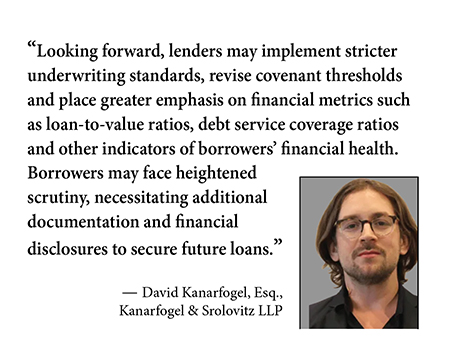By David Kanarfogel, Esq., of Kanarfogel & Srolovitz LLP
The commercial real estate industry is approaching a critical crossroad as concerns intensify regarding a potential wave of loan defaults.
The implications of such defaults and the legal mandates and guidelines that may emerge in response are of critical importance for commercial borrowers. This is because lenders could introduce new types of credit offerings and provide examples of loan workout activities that can help commercial owners and developers effectively navigate these interesting times.
To comprehend the potential impact of loan defaults, it is crucial to grasp the current landscape of commercial lending. Over the past few years, lending in the industry has experienced a surge, resulting in a substantial number of loans approaching maturity. However, economic uncertainties and market volatility brought about by the pandemic, historic inflation and the fickle interest rate outlook have heightened concerns about borrowers’ ability to fulfill their loan obligations — and about what the next steps will be for both lenders and borrowers.
Added to that are slowed growth or even reductions in property valuations, which complicates the underwriting for such loans, and with that the prospects for refinance, sale or other credit options that borrowers often have access to. The totality of the situation has experts and industry insiders speculating about the possibility of a significant increase in commercial loan defaults. While the extent of this wave remains uncertain, stakeholders across the industry are closely monitoring the situation — you’ve surely seen it in across the pages of recent issues of trade magazines.
Should the speculated level of defaults materialize, it is likely to trigger a series of legal and regulatory responses aimed at addressing the challenges faced by the industry. These will include a mix of the three goals that policymakers typically think about when they respond to a crisis: maintain overall economic stability, build bulwarks against a worsening of the crisis (here, more tightening of credit) and restructure the cycle to minimize future downturns.
What might this mix of regulatory responses look like? Legislators may introduce new legal mandates involving loan restructuring and temporary relief measures to support borrowers during times of financial distress, as happened during the housing credit crisis in the late 2000s. Increased oversight and reporting requirements for lenders and borrowers may also be imposed to mitigate systemic risks and ensure transparency in loan transactions.
Any commercial sector with potential impacts on housing will likely see particular attention from lawmakers. Given the momentum behind trends toward use conversion to housing in some jurisdictions, defaults may provide regulatory leverage to build or expand programs that encourage such conversations. Guidelines surrounding loan covenants and agreements are also expected to evolve to adapt to the changing landscape as well.
Lenders themselves will respond even without governmental action. Most lenders are in the business of making smart loans that generate healthy returns, and they dislike protracted periods of defaults and credit crunches as much as borrowers. Looking forward, lenders may implement stricter underwriting standards, revise covenant thresholds and place greater emphasis on financial metrics such as loan-to-value ratios, debt service coverage ratios and other indicators of borrowers’ financial health. Borrowers may face heightened scrutiny, necessitating additional documentation and financial disclosures to secure future loans.
But lenders may also look backwards as well: to help stave off some defaults, some lenders will introduce new credit offerings or support workouts. For instance, lenders may expand their bridge and mezzanine loan financing options to help borrowers bridge temporary cash flow gaps or fund necessary property improvements.
“Loan workout” is a broad term for negotiating with lenders to find viable solutions to address financial difficulties. Loan modifications, for example, can involve adjusting interest rates, extending loan terms or revising repayment schedules to provide temporary relief. Debt restructuring is another option, allowing borrowers to renegotiate the terms of the loan to reduce payment amounts or restructure capital stacks. In some cases, borrowers may need to consider asset sales or bringing in joint venture equity to improve their financial position.
A few other specific workout options are worth knowing:
- Loan assumptions, where a new borrower assumes the existing loan terms and obligations, allowing the original borrower to transfer ownership while avoiding default. This approach requires lender consent and careful evaluation of the new borrower’s financial strength.
- Short sales, in which the property is sold for less than the outstanding loan balance with lender consent. While it may result in a loss for the borrower, a short sale can help avoid foreclosure and mitigate further financial damage.
- Loan forbearance agreements, which provide temporary payment relief or modified terms for borrowers experiencing financial hardship. These agreements can involve reducing or deferring payments for a specific period, allowing borrowers to regain financial stability.
- Deed-in-lieu of foreclosure, an option wherein borrowers transfer property ownership to the lender, effectively relinquishing the property to avoid the lengthy foreclosure process. This alternative can be less damaging to the borrower’s credit history than a foreclosure.
Each of these loan workout activities requires careful consideration of the potential impacts on the borrower’s financial situation, long-term objectives and the property’s value. Commercial real estate owners and developers facing financial distress or potential loan defaults should familiarize themselves with various loan workout activities. Engaging with experienced legal and financial advisors is crucial to assess the most suitable approach and navigate the complexities of these workout strategies effectively.
As the commercial real estate industry prepares for a speculated wave of loan defaults, it is essential for stakeholders to remain vigilant and adapt to the evolving landscape. New legal mandates and guidelines will shape the industry’s response to potential defaults, influencing lenders’ credit offerings and borrowers’ loan workout activities.
By proactively engaging with legal and financial experts, commercial real estate owners and developers can navigate these challenges more effectively, safeguard their investments and position themselves for future success.
— Kanarfogel & Srolovitz LLP is a New York-based corporate law firm specializing in real estate, finance and trust cases.


